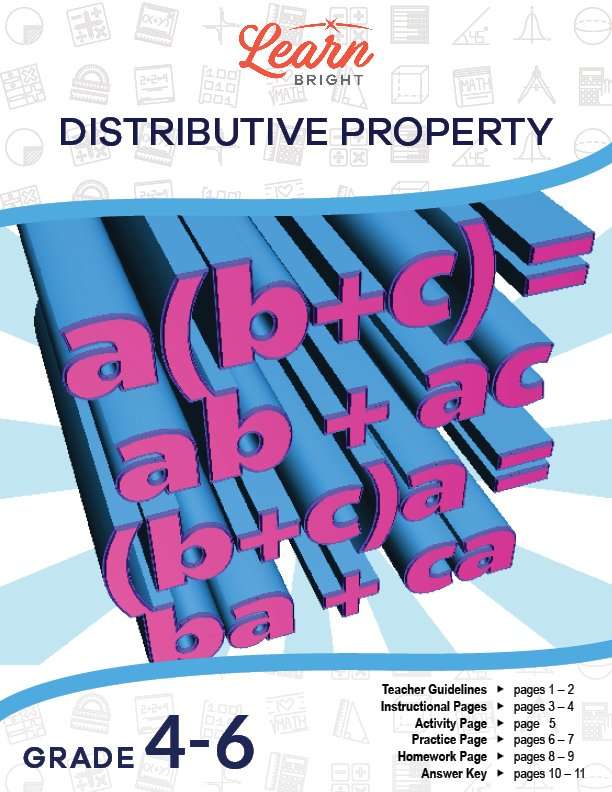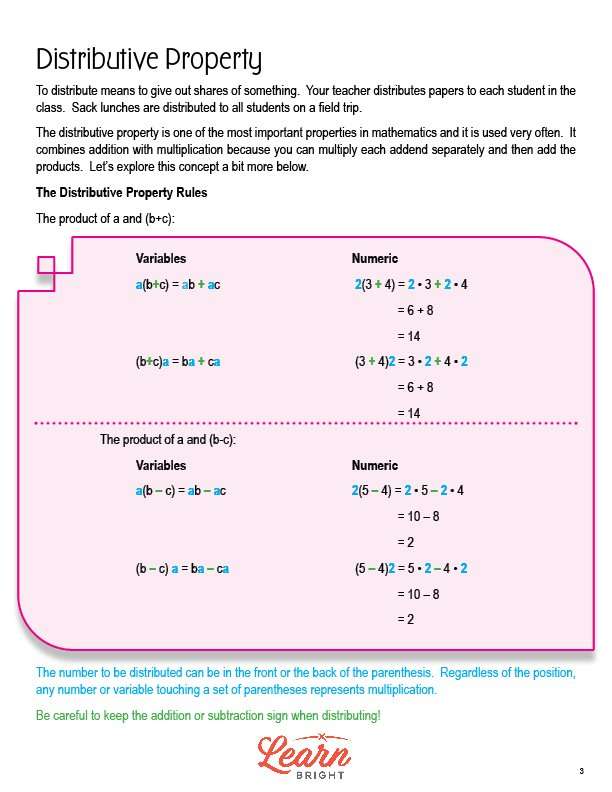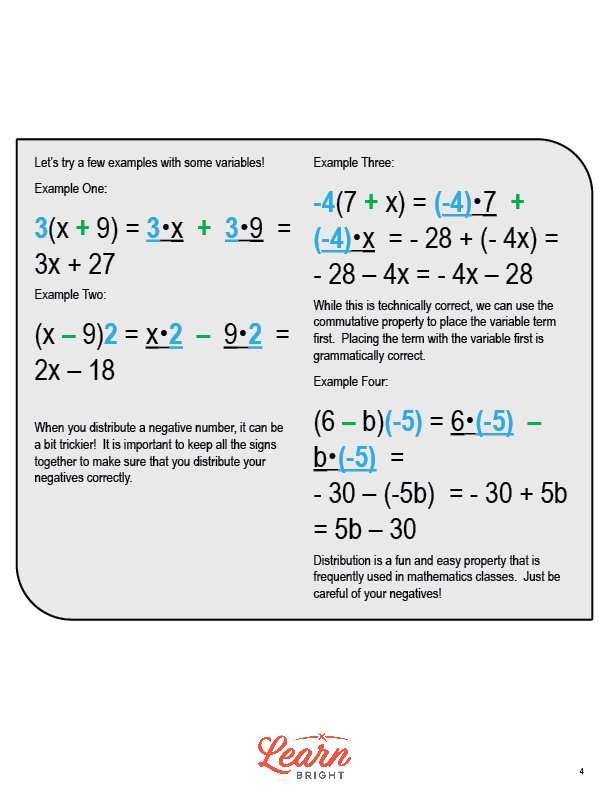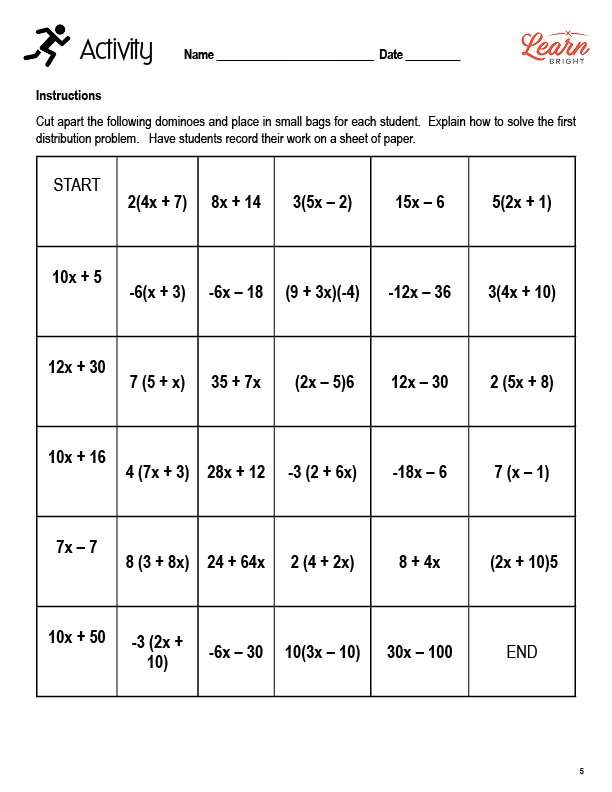Description
What our Distributive Property lesson plan includes
Lesson Objectives and Overview: Distributive Property explains the distributive property to students, listing its rules and providing examples using both positive and negative numbers. The Distributive property is a very important algebraic property, combining addition and subtraction as well as multiplication. At the end of the lesson, students will be able to understand and apply the distributive property. This lesson is for students in 4th grade, 5th grade, and 6th grade.
Classroom Procedure
Every lesson plan provides you with a classroom procedure page that outlines a step-by-step guide to follow. You do not have to follow the guide exactly. The guide helps you organize the lesson and details when to hand out worksheets. It also lists information in the blue box that you might find useful. You will find the lesson objectives, state standards, and number of class sessions the lesson should take to complete in this area. In addition, it describes the supplies you will need as well as what and how you need to prepare beforehand. The supplies that you will need for this lesson include scissors, glue, and paper.
Options for Lesson
Included with this lesson is an “Options for Lesson” section that lists a number of suggestions for activities to add to the lesson or substitutions for the ones already in the lesson. One optional addition to this lesson is to have students use a dice to roll problems for the class. You can also have your students write their own problem then shift to the left to solve, write another and shift again to solve until the original paper returns to the first person.
Teacher Notes
The teacher notes page includes lines that you can use to add your own notes as you’re preparing for this lesson.
DISTRIBUTIVE PROPERTY LESSON PLAN CONTENT PAGES
Distributive Property
The Distributive Property lesson plan includes two content pages. Distributing means giving out shares of something. For example, your teacher may distribute papers to each student in the class. Or, on a field trip, bagged lunches may be distributed to each student.
One of the most important properties in mathematics is the distributive property. We use it all the time. This property combines addition with multiplication in that you can multiply each addend separately and then add the products to find the answer.
The Distributive Property Rules
The lesson then shows how to solve a problem using the distributive property, using both variables and numbers. To find the product of a and (b+c), using variables, you can use the following equations: a(b+c) = ab + ac or (b+c)a = ba + ca. You can solve this way if you have specific numbers. In this example, a = 2, b = 3, and c = 4. To solve using either variable equation, you would first substitute in the numbers for the letters and then solve. In both cases, the answer is 14.
To find the product of a and (b-c), using variables, you can use the following equations: a(b-c) = ab – ac or (b-c)a = ba – ca. You can solve this way if you have specific numbers. In this example, a = 2, b = 5, and c = 4. To solve using either variable equation, you would first substitute in the numbers for the letters and then solve. In both cases, the answer is 2.
You can place the number that you want to distribute in the front or back of the parenthesis. No matter its position, a number or variable that touches a set of parentheses requires multiplication. Make sure to keep the addition or subtraction sign when you distribute!
The lesson closes by walking through four example problems step-by-step to help reinforce students’ understanding of how to use the distributive property.
DISTRIBUTIVE PROPERTY LESSON PLAN WORKSHEETS
The Distributive Property lesson plan includes four worksheets: an activity worksheet, a practice worksheet, a homework assignment, and a quiz. You can refer to the guide on the classroom procedure page to determine when to hand out each worksheet.
DOMINOES ACTIVITY WORKSHEET
The activity worksheet asks students to solve the problems on “dominoes” (small pieces of paper) that they pull from a container. They will record their work on a sheet of paper.
SIMPLIFYING EXPRESSIONS PRACTICE WORKSHEET
For the practice worksheet, students will simplify expressions using the distributive property. They will show their work.
DISTRIBUTIVE PROPERTY HOMEWORK ASSIGNMENT
The homework assignment asks students to rewrite problems using the distributive property and then solve.
QUIZ
This lesson also includes a quiz that you can use to test students’ understanding of the lesson material. For the quiz, students will look at two sets of equations and determine which choice in each set best shows the distributive property.
Worksheet Answer Keys
This lesson plan includes answer keys for the practice worksheet, the homework assignment, and the quiz. If you choose to administer the lesson pages to your students via PDF, you will need to save a new file that omits these pages. Otherwise, you can simply print out the applicable pages and keep these as reference for yourself when grading assignments.









